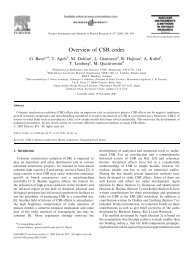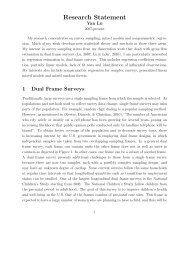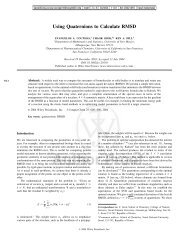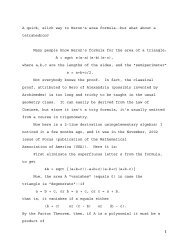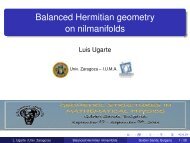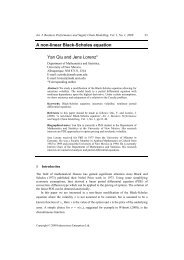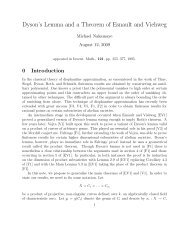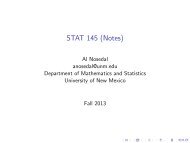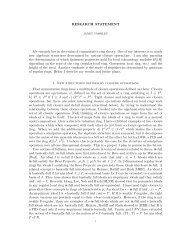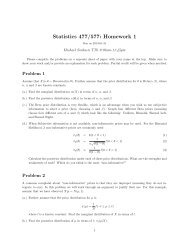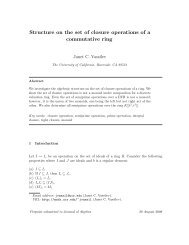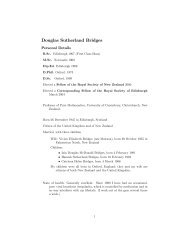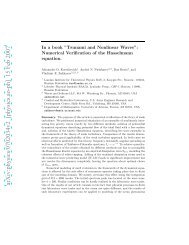OEO Office of Equal Opportunity - Department of Mathematics and ...
OEO Office of Equal Opportunity - Department of Mathematics and ...
OEO Office of Equal Opportunity - Department of Mathematics and ...
You also want an ePaper? Increase the reach of your titles
YUMPU automatically turns print PDFs into web optimized ePapers that Google loves.
146 ARTS AND SCIENCES<br />
365./568. Anthropology <strong>of</strong> Health. (3) Hurtado<br />
Analysis <strong>of</strong> systems <strong>of</strong> health, curing <strong>and</strong> disease in aboriginal,<br />
western <strong>and</strong> pluralistic societies. (B, HEE) {Offered<br />
periodically}<br />
366./566. Tropical Conservation <strong>and</strong> South American<br />
Indians. (3)<br />
Examines resource use patterns by Amazonian Indians <strong>and</strong><br />
recent collaboration or conflict with conservation organizations.<br />
(B, HEE) {Offered periodically}<br />
368./565. Modern Hunter-Gatherers. (3) Hill<br />
Examination <strong>of</strong> behavioral variation in modern foraging<br />
populations from a comparative <strong>and</strong> ecological perspective.<br />
Includes traditional societies <strong>of</strong> Africa, Asia, Australia, North<br />
<strong>and</strong> South America. (B, HEE) {Alternate years}<br />
369./564. Observing Primate Behavior. (4) Lancaster<br />
Various methods <strong>of</strong> observational data collection on human<br />
<strong>and</strong> nonhuman primates will be examined. Student designed<br />
research on campus or at the zoo will focus on the importance<br />
<strong>of</strong> determining appropriate data collection methods.<br />
Recommended: Upper division st<strong>and</strong>ing <strong>and</strong> 360 or 362 or<br />
363. Can be taken concurrently with 363. (HEE) {Alternate<br />
years}<br />
372./572. Analytic Methods in Anthropology. (4)<br />
Introduction to basic qualitative <strong>and</strong> quantitative analytic<br />
methods in anthropology. (A) }<br />
*373. Technical Studies in Archaeology. (3 to a maximum<br />
<strong>of</strong> 6) ∆<br />
Technical course with variable content dealing with such<br />
issues as dating, paleoenvironmental <strong>and</strong> subsistence studies<br />
in archaeology. (A) {Offered periodically}<br />
375./575. Archaeology Field Session. [Summer<br />
Archaeology Field Session.] (2-6 to a maximum <strong>of</strong> 12) ∆<br />
Wills, Huckell, Ramen<strong>of</strong>sky<br />
Intensive instruction in archaeological field <strong>and</strong> laboratory<br />
techniques <strong>and</strong> the opportunity for independent student<br />
research.<br />
Restriction: permission <strong>of</strong> instructor. (A)<br />
*380. Women Culture & Society. (3)<br />
(Also <strong>of</strong>fered as WMST 380.) An overview <strong>of</strong> women’s <strong>and</strong><br />
men’s experience in our own <strong>and</strong> other cultures. We will read<br />
case studies about gender relations in Native North America,<br />
Mexico, Africa, the Middle East <strong>and</strong> differing ethnic <strong>and</strong> class<br />
segments <strong>of</strong> the U.S. Issues to be covered include reproduction,<br />
the family, work <strong>and</strong> colonialism. (E)<br />
381./581. Ethics in Anthropology: A Four Field<br />
Approach. (3)<br />
The class examines topical issues such as human rights,<br />
indigenous rights, researcher rights, <strong>and</strong> pr<strong>of</strong>essional <strong>and</strong><br />
scientific responsibility that face the various subfields <strong>of</strong><br />
anthropology in its everyday practice. {Spring}<br />
384./584. Peoples <strong>of</strong> Mexico. (3)<br />
Emergence <strong>of</strong> the modern Indian <strong>and</strong> Mestizo cultures <strong>of</strong><br />
Mexico <strong>and</strong> Guatemala. Persistence <strong>and</strong> change in social<br />
institutions <strong>and</strong> cultural patterns. (E) {Alternate years}<br />
385./588. Images <strong>of</strong> the Indian in American Culture. (3)<br />
Analysis <strong>of</strong> literary, historical, ethnographic <strong>and</strong> contemporary<br />
texts, written by both Indians <strong>and</strong> non-Indians, to underst<strong>and</strong><br />
Native American peoples’ reaction <strong>and</strong> adjustment to conquest<br />
<strong>and</strong> domination. (E) {Offered periodically}<br />
Prerequisite: 331.<br />
387./587. Peoples <strong>and</strong> Cultures <strong>of</strong> the Circum-<br />
Caribbean. (3)<br />
(Also <strong>of</strong>fered as AFAM 386.) Outlines the sociocultural transformation<br />
<strong>of</strong> the region since 1492. Emphasis upon cultural<br />
legacies <strong>of</strong> <strong>and</strong> resistance to colonialism, the Afro-Caribbean<br />
<strong>and</strong> Hispanic heritages, <strong>and</strong> the contemporary trans-nationalization<br />
<strong>of</strong> isl<strong>and</strong> identities. (E)<br />
390./590. Archaeology <strong>of</strong> the Southern Great Plains. (3)<br />
This course provides an introduction to the environment,<br />
physiography, <strong>and</strong> human cultures <strong>of</strong> the Southern Great<br />
Plains <strong>of</strong> Northern America from its earliest peopling to<br />
the time <strong>of</strong> European exploration <strong>of</strong> the region. {Alternate<br />
years}<br />
393. Ancient New Mexico I. (3) Stuart<br />
Ancient New Mexico is Part I <strong>of</strong> a two-semester general<br />
series on the archaeology <strong>of</strong> New Mexico. The period <strong>of</strong> New<br />
Mexico’s earliest settlement at 10,000 B.C. to the advent <strong>of</strong><br />
early pithouse villages at about A.D. 500 is covered each fall<br />
semester. (A) {Alternate years}<br />
394. Ancient New Mexico II. (3) Stuart<br />
Ancient New Mexico is Part II <strong>of</strong> a two-semester general<br />
series on the archaeology <strong>of</strong> New Mexico. The period from<br />
the advent <strong>of</strong> early pithouse villages (A.D. 500) through the<br />
rise <strong>and</strong> fall <strong>of</strong> Chacoan Society, to the arrival <strong>of</strong> Spanish settlers<br />
in 1595. (A) {Alternate years}<br />
399. Introduction to Field & Laboratory Research. (1-6,<br />
no limit) † ∆<br />
Directed study under the supervision <strong>of</strong> a faculty member.<br />
Restriction: permission <strong>of</strong> instructor. (A, B, E, HEE) {Offered<br />
upon dem<strong>and</strong>}<br />
401./501. Native American Art I. (3) Szabo<br />
(Also <strong>of</strong>fered as ARTH 402.) Prehistoric <strong>and</strong> historic art forms<br />
<strong>of</strong> the Arctic, Northwest Coast <strong>and</strong> the eastern woodl<strong>and</strong>s <strong>of</strong><br />
North America. (E) {Fall}<br />
402./582. Museum Practices. (3 to a maximum <strong>of</strong> 9) ∆<br />
(Also <strong>of</strong>fered as MSST, ARTH 407.) History, philosophy <strong>and</strong><br />
purposes <strong>of</strong> museums. Techniques <strong>and</strong> problems <strong>of</strong> museum<br />
administration, education, collection, exhibition, conservation<br />
<strong>and</strong> public relations. (E)<br />
403./503. Native American Art II. (3) Szabo<br />
(Also <strong>of</strong>fered as ARTH 406.) Prehistoric <strong>and</strong> historic art<br />
forms <strong>of</strong> the Plains, Southwest <strong>and</strong> western regions <strong>of</strong> North<br />
America. (E) {Spring}<br />
410./510. Topics in Linguistic Anthropology. (3 to a<br />
maximum <strong>of</strong> 15) ∆<br />
Topics from various areas <strong>of</strong> anthropological linguistics<br />
including, but not limited to, ethnosemantics, the ethnography<br />
<strong>of</strong> communication <strong>and</strong> the biology <strong>of</strong> language. (E)<br />
413./512. Linguistic Field Methods. (3) Gorbet<br />
(Also <strong>of</strong>fered as LING 413.) Practice in transcribing from<br />
oral dictation, phonemic analysis, introduction to problems<br />
<strong>of</strong> morphology.<br />
Prerequisite: 317. Restriction: permission <strong>of</strong> instructor. (E)<br />
{Offered upon dem<strong>and</strong>}<br />
415./515. Native American Languages. (3)<br />
(Also <strong>of</strong>fered as LING 415.) Survey <strong>of</strong> Indian languages <strong>of</strong><br />
North America, with special emphasis on languages <strong>of</strong> New<br />
Mexico. Topics: linguistic structure in particular languages<br />
<strong>and</strong> language families; relationship <strong>of</strong> languages <strong>and</strong> cultures;<br />
<strong>and</strong> language loss, maintenance <strong>and</strong> preservation. (E)<br />
416./516. Introduction to Language Change. (3)<br />
(Also <strong>of</strong>fered as LING 446.) Theories <strong>and</strong> methods <strong>of</strong> comparative<br />
<strong>and</strong> historical linguistics, emphasizing change in<br />
English, Indo-European <strong>and</strong> Native American languages.<br />
Prerequisite: 317. (E) {Alternate years}<br />
*420. Topics in Archaeology. (3 to a maximum <strong>of</strong> 15) ∆<br />
Topics <strong>of</strong> archaeological interest including gender in archaeology,<br />
European contact <strong>and</strong> post-processualism. (A)<br />
*421. Historical Archaeology <strong>of</strong> the Spanish<br />
Borderl<strong>and</strong>s. (3) Ramen<strong>of</strong>sky<br />
Using archaeology <strong>and</strong> history, this course focuses on<br />
change <strong>and</strong> continuity <strong>of</strong> native populations that occurred<br />
with Spanish colonization across the Borderl<strong>and</strong>s. Topics<br />
include demography, missionization, technologies <strong>and</strong> settle-<br />
UNM CATALOG 2006–2007 Symbols, page 611.



